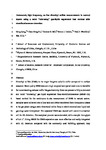Automated, high frequency, on-line dimethyl sulfide measurements in natural waters using a novel “microslug” gas-liquid segmented flow method with chemiluminescence detection
| dc.contributor.author | Leng, G | |
| dc.contributor.author | Jin, C-F | |
| dc.contributor.author | Bell, TG | |
| dc.contributor.author | Ussher, Simon | |
| dc.contributor.author | Worsfold, Paul | |
| dc.contributor.author | Li, W-Y | |
| dc.date.accessioned | 2020-09-07T12:26:19Z | |
| dc.date.available | 2020-09-07T12:26:19Z | |
| dc.date.issued | 2021-01-01 | |
| dc.identifier.issn | 0039-9140 | |
| dc.identifier.issn | 1873-3573 | |
| dc.identifier.other | 121595 | |
| dc.identifier.uri | http://hdl.handle.net/10026.1/16230 | |
| dc.description.abstract |
Dimethyl sulfide (DMS) is the major biogenic volatile sulfur compound in surface seawater. Good quality DMS data with high temporal and spatial resolution are desirable for understanding reduced sulfur biogeochemistry. Here we present a fully automated and novel "microslug" gas-liquid segmented flow-chemiluminescence (MSSF-CL) based method for the continuous in-situ measurement of DMS in natural waters. Samples were collected into a flow tank and DMS transferred from the aqueous phase to the gas phase using a vario-directional coiled flow, in which microvolume liquid and gas slugs were interspersed. The separated DMS was reacted with ozone in a reaction cell for CL detection. The analytical process was automated, with a sample throughput of 6.6 h-1. Using MSSF for DMS separation was more effective and easily integrated with CL detection compared with the commonly used bubbling approach. Key parameters of the proposed method were investigated. The linear range for the method was 0.05-500 nM (R2 = 0.9984) and the limit of detection (3 x S/N) was 0.015 nM, which is comparable to the commonly used gas chromatography (GC) method and sensitive enough for direct DMS measurement in typical aquatic environments. Reproducibility and recovery were assessed by spiking natural water samples (river, lake, reservoir and pond) with different concentrations of DMS (10, 20 and 50 nM), giving relative standard deviations (RSDs) ≤1.75% (n = 5) and recoveries of 94.4-107.8%. This fully automated system is reagent free, easy to assemble, simple to use, portable (weight ~5.1 kg) and can be left in the field for several hours of unattended operation. The instrumentation can provide high quality DMS data for natural waters with an environmentally relevant temporal resolution of ~9 min. | |
| dc.format.extent | 121595-121595 | |
| dc.format.medium | Print-Electronic | |
| dc.language | en | |
| dc.language.iso | en | |
| dc.publisher | Elsevier BV | |
| dc.subject | Dimethyl sulfide | |
| dc.subject | Chemiluminescence | |
| dc.subject | Natural waters | |
| dc.subject | Segmented flow | |
| dc.subject | Automated | |
| dc.subject | On site analysis | |
| dc.title | Automated, high frequency, on-line dimethyl sulfide measurements in natural waters using a novel “microslug” gas-liquid segmented flow method with chemiluminescence detection | |
| dc.type | journal-article | |
| dc.type | Journal Article | |
| plymouth.author-url | https://www.webofscience.com/api/gateway?GWVersion=2&SrcApp=PARTNER_APP&SrcAuth=LinksAMR&KeyUT=WOS:000579910600085&DestLinkType=FullRecord&DestApp=ALL_WOS&UsrCustomerID=11bb513d99f797142bcfeffcc58ea008 | |
| plymouth.volume | 221 | |
| plymouth.publication-status | Published | |
| plymouth.journal | Talanta | |
| dc.identifier.doi | 10.1016/j.talanta.2020.121595 | |
| plymouth.organisational-group | /Plymouth | |
| plymouth.organisational-group | /Plymouth/Faculty of Science and Engineering | |
| plymouth.organisational-group | /Plymouth/Faculty of Science and Engineering/School of Geography, Earth and Environmental Sciences | |
| plymouth.organisational-group | /Plymouth/REF 2021 Researchers by UoA | |
| plymouth.organisational-group | /Plymouth/REF 2021 Researchers by UoA/UoA07 Earth Systems and Environmental Sciences | |
| plymouth.organisational-group | /Plymouth/Research Groups | |
| plymouth.organisational-group | /Plymouth/Research Groups/BEACh | |
| plymouth.organisational-group | /Plymouth/Research Groups/Marine Institute | |
| plymouth.organisational-group | /Plymouth/Users by role | |
| plymouth.organisational-group | /Plymouth/Users by role/Academics | |
| plymouth.organisational-group | /Plymouth/Users by role/Researchers in ResearchFish submission | |
| dc.publisher.place | Netherlands | |
| dcterms.dateAccepted | 2020-08-26 | |
| dc.rights.embargodate | 2021-9-1 | |
| dc.identifier.eissn | 1873-3573 | |
| dc.rights.embargoperiod | Not known | |
| rioxxterms.funder | Natural Environment Research Council | |
| rioxxterms.identifier.project | Carbon Uptake and Seasonal Traits in Antarctic Remineralisation Depth (CUSTARD) | |
| rioxxterms.versionofrecord | 10.1016/j.talanta.2020.121595 | |
| rioxxterms.licenseref.uri | http://www.rioxx.net/licenses/all-rights-reserved | |
| rioxxterms.licenseref.startdate | 2021-01-01 | |
| rioxxterms.type | Journal Article/Review | |
| plymouth.funder | Carbon Uptake and Seasonal Traits in Antarctic Remineralisation Depth (CUSTARD)::Natural Environment Research Council | |
| plymouth.funder | Carbon Uptake and Seasonal Traits in Antarctic Remineralisation Depth (CUSTARD)::Natural Environment Research Council |


